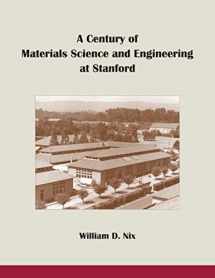
A Century of Materials Science and Engineering at Stanford: From Steels to Semiconductors to Nano- and Bio-Materials
Book details
Summary
Description
Materials Science at Stanford has deep roots in the University’s history. Slowly emerging from Geology and Mining, one of Stanford’s oldest departments, the future materials science program experienced more than one short-lived jump-start by metallurgists and chemists before its formal 1919 creation as the Department of Mining and Metallurgy. Few, beyond perhaps one pioneering metallurgy professor, would have predicted that his innovative 1903 course on the physics of metals would lead to today’s Department of Materials Science & Engineering, one of the premier materials science departments in the world. In celebration of the MSE Department’s centennial, 1919-2019, William D. Nix, professor emeritus and former department chair, documents the opportunities and challenges experienced by this comparatively small department in a highly competitive and ambitious university environment. Nix, a member of the department for 60 years as a graduate student and professor, draws on his knowledge and experience as well as university documents and publications, informal departmental histories, and personal interviews. This work is more than a celebratory means to document the people and events making up the history of the department. It also follows the evolution of Stanford’s metallurgy and, later, materials science program within a broader framework of its academic competitors, and in response to changing society and industry needs. The author also addresses an ongoing challenge, to attract and support women to the field, as students and especially as tenured faculty. The study of materials at Stanford initially focused on ore extraction and processing as part of its mining engineering curriculum. As the field developed, Stanford metallurgists turned to thermal and mechanical processing and properties of metals. Through this evolving interest, the field of materials science and engineering was born. Between the world wars, faculty developed a notable expertise with the compositions, microstructures, and properties of steels but after World War II, they turned their attention to nuclear power and aerospace applications, including the study of metals such as aluminum, magnesium, and titanium alloys. Work on silicon and other semi-conductors emerged from the development of micro-electronics during the 1960s and 1970s, and, subsequently, work on electro-chemical materials, with applications for batteries and fuel cells. While the department continues its research on and teaching about materials for microelectronic and electro-chemical devices, it has also turned to broader fields of nano-sciences and biosciences, with a special interest in the environment, biology, and medicine.


We would LOVE it if you could help us and other readers by reviewing the book
Book review



